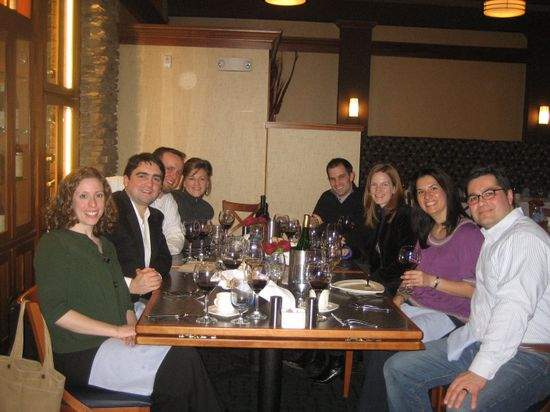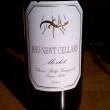The Moment When a Finger Lakes Wine Lover Was Sold on Long Island
From left to right: Katie Feulner, Jason Feulner, Lenn Thompson, Nena Thompson, Evan Dawson, Morgan Dawson, Melissa Dobson, Rich Dobson
By Evan Dawson, Finger Lakes Correspondent
Everyone who loves wine has a memory that stands out with perfect clarity thanks to a single bottle of wine. We remember the meal, the lighting in the room, the conversations shared over the bottle. This is the power of wine.
It is far more than a beverage.
If we are fortunate, we have not one special wine memory, but many. I will never forget the moment I drank the first sip of Rosso del Bepi from Giuseppe Quintarelli. I can tell you how many people were in the room and what they were saying when I drank my first glass of Ravines 2005 Pinot Noir. I remember being frozen in place, unable to move as I first tried Jean-Michel Stephan's Cote Rotie. And my wife and I will always smile as we recount the opening of a bottle of Hermann Wiemer 1994 Riesling.
Last night I added a new wine memory to the collection.
As Lenn mentioned, he joined Jason, Melissa, me, and our spouses for a LENNDEVOURS dinner at the new Watkins Glen Harbor Hotel. Lenn brought several bottles of Long Island wine for the occasion, and one of them was a bottle I had long desired to try: the Grapes of Roth 2002 Merlot. We split the meal between Finger Lakes whites from the restaurant menu and Lenn's cache of Long Island reds. Before we even ordered we opened the Grapes of Roth and poured it into our glasses to encourage the wine to open up.
My experience with Long Island wines remains rather limited, so I was excited not only to drink more Long Island wine, but to drink a wine with such a strong reputation. But some of the most satisfying wine memories are rooted in surprise. When we finally arrived at the main course — a simple and perfectly cooked Filet for me — I picked up the glass like a child picks up a wrapped present. After taking in the rich, intense nose, I found that the wine was… good. Very good, even. I did not expect the intense spice and white pepper on the palate, and it was a gorgeous match with the beef.
But "very good" wine does not engender lifelong memories. And so I can concede my utter astonishment with the next wine that Lenn opened — the Paumanok Vineyards 2000 Grand Vintage Cabernet Sauvignon.
This nose of this wine was like pure, fresh asparagus. Maybe — if you peeled back the asparagus — you could find some roasted Brussels sprouts. There was very little fruit in the nose (I'm assuming it's receded with some bottle age). And I loved it immediately.
That's because the wine brought a delicate balance of dark fruit and green flavors on the palate. It evoked my favorite French wines without seeming like a pale knockoff. It was long. And I'll always remember the look on Nena's face when she caught me staring at the glass, agape after my first sip. "Isn't this amazing?" she said.
To conclude a story that is undoubtedly too long already, let me reiterate my small sample size in tasting Long Island wines. Most have been quite pleasant, but none has moved me like this. But now I am emboldened to seek out more. I hope to get a better feel for what Long Island's varietal characters are. If they are anything like the 2000 Paumanok, well, I'll just have to find a way to expand my wine budget.
What are your special wine memories?
















The ‘gottcha’ wine for me was a Mondavi Pinot Noir Reserve from the ’70′s, Yah, I guess I’m showing my age here, but it was the first time I really understood what wine was about. The first time I understood that we were making great wines in New York was at the Vintage store, here in town, where I had the pleasure of tasting a 2003 Jamesport Estate Merlot. It had complexity, fruit, and balance; all the good stuff that makes for a special wine. It also had a characteristic that I have come to associate only with small farm wineries: an ineffable care and attachment to the land that shows in the wine. This characteristic seems missing from wines from large output producers. Their product may, sometimes, be technically superior, but it seems to lack ardor or passion in comparison. There are certainly wines that have this same something (terroir, soul, who knows?) from other regions, but only from small producers. The pleasure of New York wines is that nearly all are produced by small farms.
Alvin,
I like the term “gotcha wine.” I’ll usurp that with your permission! Interesting to see the dichotomy of your gotcha wines — the first from a large producer (though in the 1970s RM was making far less, probably 250 to 500k cases by the end of the decade) and the second from a vastly different entity.
Usurp away, enjoy.
Re Mondavi and Jamesport: I like to think that my tastes have matured with the graying of my hair. In any case, there was a lot of enthusiasm coming out of Cali in the ’60′s early ’70′s, especially leading up to the time of the Judgments of Paris. In many ways the current state of the NY wine industry, albeit on a smaller scale, is similar to what California was at that time. So much promise, enthusiasm, and courage to experiment.
Robert was on his way to becoming Megawine Corp, but it was one of the best wine a soul could acquire in a Pennsylvania State Store. Where I grew up Lancers and Blue Nun were considered exotic so this was an eye opener.
The one part of Mondavi that I can’t seem to reconcile was his simultaneous desire to produce fine, world-class wines — while also blowing production off the charts. His brother was making a million cases at Krug, so perhaps the sibling rivalry played a part, but those two things do seem to be mutually exclusive. The book about the family (House of Mondavi) doesn’t shed much light on that issue.
Your comment reminded me of something Mark Miller observed in his autobiography. He stated that the wine industry didn’t understand what was going on in the late sixties and early seventies. They just didn’t comprehend that the changes were a paradigm shift. They didn’t realize that America was developing a taste for elegant wines; it certainly hadn’t been the case in the past. It had been common wisdom that to be able to make money in the wine industry one had to get REALLY BIG. It was the business model that had historically worked, e.g. Gallo, Taylor, Krug, Canandaigua, Virginia Dare and etc. Could explain Mondavi standing with a foot in each camp. Certainly an interesting question.